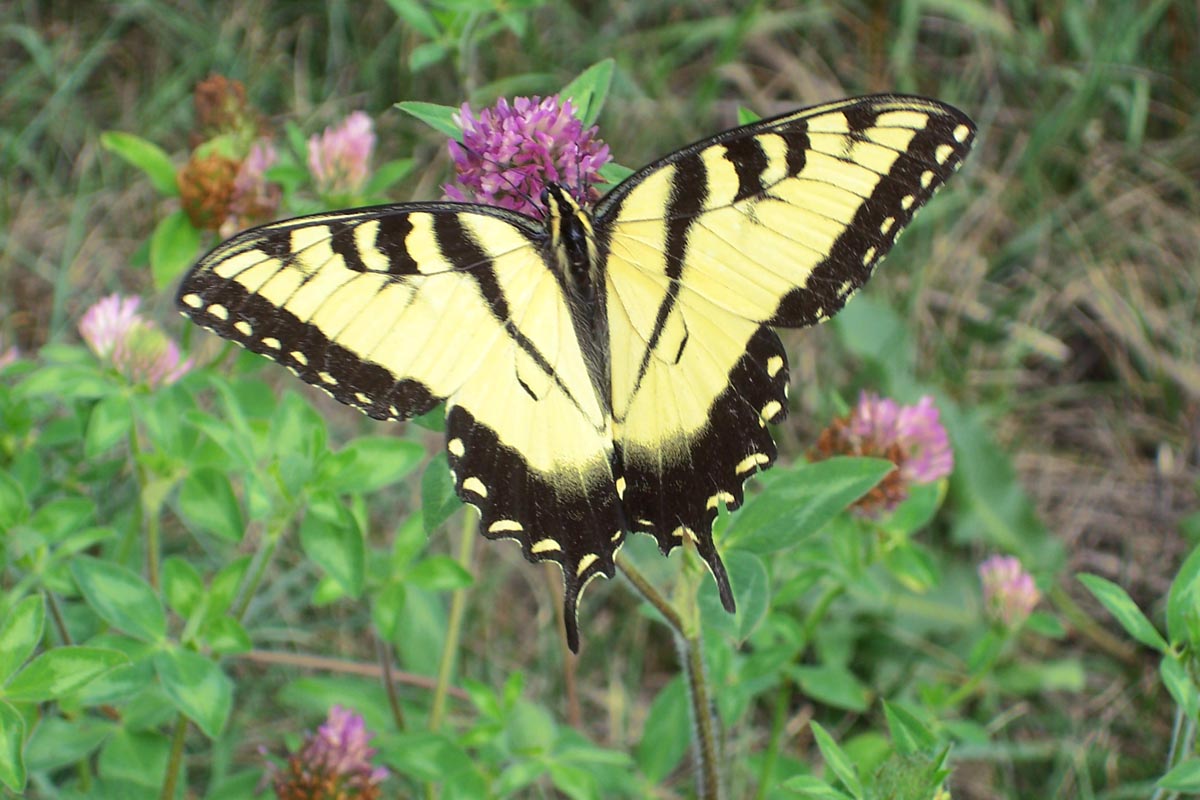- Eastern tiger swallowtail
__NOTOC__Taxobox
name = Eastern tiger swallowtail

image_width = 204px
image_caption = Male (see gallery for female)
status = NE
regnum =Animal ia
phylum =Arthropod a
classis =Insect a
ordo =Lepidoptera
super_familia =Rhopalocera
familia =Papilionidae
genus = "Papilio "
species = "P. glaucus"
binomial = "Papilio glaucus"
binomial_authority = Linnaeus,1758 The Eastern tiger swallowtail, "Papilio glaucus", is a large (12 cm wingspan)
swallowtail butterfly . It is found in the EasternUnited States , as far north as southernVermont , and as far West as extreme EasternColorado . It flies from spring through fall, and most of the year in the southern portions of its range, where it may produce two or three broods a year. In theAppalachia n region, it is replaced by the closely-related and only recently described larger-sized "Papilio appalachiensis ", and in the north, it is replaced by the closely-related "Papilio canadensis ". These three species can be very difficult to distinguish, and were formerly all considered to be a single species.Adult males are yellow, with four black "tiger stripes" on each fore wing. The trailing edges of the fore and hind wings are black which is broken with yellow spots. On the medial margin of the hind wing next to the abdomen there are small red and blue spots.
There are two morphs of adult females, a yellow and a dark one. The yellow morph is similar to the male, except that the hind wings have an area of blue between the black margin and the main yellow area. In the dark morph, most of the yellow areas are replaced with a dark gray to a black. A shadow of the "tiger stripes" can still be seen on the dark females. The dark form is more common in the Southern portions of the range, especially in areas also inhabited by the
Pipevine Swallowtail , which it seems tomimic .Eastern Tiger Swallowtails often rest with their wings fully spread, particularly if the sun is out.
Female lays spherical green eggs on the top of leaves of host plants. After hatching, the caterpillars often eat the shell of their egg. The first
instar s are dark and mimic bird droppings. The second and thirdinstar s use mimicry camouflage to the extreme. Lying quietly on a branch or leaf the caterpillar appears to be a piece of bird excrement but if disturbed rears its head and acts like an aggressive snake similar to theHognose Snake . If disturbed enough, it will extend two red horns known asosmeterium from its underside that look like a snake's tongue. This fearsome visual disguise is often enough to frighten or fool a curious bird or predator. Thelarvae eat the leaves of a wide variety oftree s andshrub s, includingcottonwood ,tulip tree ,sweet bay ,Lemon andcherry . Adults are strictlydiurnal ; they start to fly towards noon and by and by return to rest throughout the afternoon (Fullard & Napoleone 2001).It is the state
butterfly of Georgia,Virginia ,Alabama ,South Carolina andDelaware .Image gallery
ee also
*
Two-tailed Swallowtail
*Western Tiger Swallowtail References
* (2003): "Butterflies of North America". Houghton Mifflin Co., New York
* (2001): Diel flight periodicity and the evolution of auditory defences in the Macrolepidoptera. "Animal Behaviour" 62(2): 349–368. doi|10.1006/anbe.2001.1753 [http://www.erin.utoronto.ca/~w3full/reprints/FullNapolDielAB.pdf PDF fulltext]External links
* [http://www.rlephoto.com/butterflies/swallowtail_et01.html Eastern Tiger Swallowtail: Butterflies of North Carolina]
* [http://bugguide.net/node/view/491/bgimage Eastern Tiger Swallowtails at BugGuide.net]
* [http://www.cirrusimage.com/butterfly_etigerswallow.htm Eastern Tiger Swallowtail: Diagnostic photographs] Cirrus Digital Imaging
* [http://www.cirrusimage.com/butterfly_etigerblack.htm Eastern Tiger Swallowtail: black female form diagnostic photographs] Cirrus Digital Imaging
* [http://www.npwrc.usgs.gov/resource/distr/lepid/bflyusa/usa/703.htm USGS treatment]
* [http://creatures.ifas.ufl.edu/bfly/tiger_swallowtail.htm eastern tiger swallowtail] on theUF / IFAS Featured Creatures Web site
Wikimedia Foundation. 2010.
